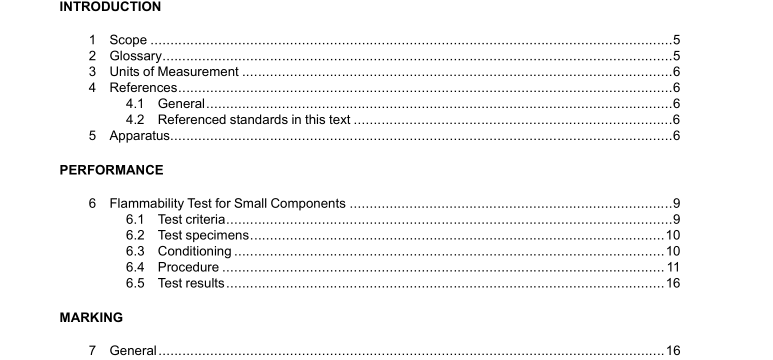UL 1694-2019 pdf download.Tests for Flammability of Small Polymeric Component Materials.
1 Scope 1.1 These requirements specify a needle-flame test to simulate the effect of small flames which may result from fault conditions within equipment in order to assess the fire hazard by a simulation technique. 1.2 This test is applicable to small components which contain materials that can not be fabricated into standardized specimens in the minimum use thickness and subjected to applicable preselection tests, such as UL 94. Test procedures specified have been determined to be applicable to small components with an overall volume of less than 2500 mm 3 (0.15 in 3 ). Test procedures may not be applicable to small components with an overall volume greater than 2500 mm 3 (0.15 in 3 ). Test results may vary between small components which are similar in construction. Consideration should be given to the individual component construction to determine the suitability of extending results obtained for one component to other similar components. 1.3 The test is applied to ensure: – that, under defined conditions, the test flame does not cause ignition of the small component, or – that a combustible small component ignited by the test flame under defined conditions has a limited extent of burning and burning time, or – that a combustible small component ignited by the test flame under defined conditions which is totally consumed has a limited burning time. 1.4 These requirements do not cover plastics when used as materials for building construction or finishing.
2 Glossary 2.1 RISK OF FIRE – A risk of fire is considered to exist at any two points in a circuit where: a) The open circuit voltage is more than 42.4 V peak and the energy available to the circuit under any condition of load, including short circuit, results in a current of 8 A or more after 1 minute of operation, or b) A power of more than 15 W can be delivered into an external resistor connected between the two points. 2.2 FLAME CONFIRMATION – The time for the temperature of the copper block, described in Figure 5.1 to increase from 100°C to 700°C shall be 23.5 s ±1.0 s, when the flame test arrangement of Figure 5.2 is used. 2.3 EXTENT OF BURNING – The extent of burning is measured after the specimen has been allowed to cool down to approximately room temperature and has been cleaned by means of a clean dry cloth. Extent of burning denotes the distance measured between the center of the area where the test flame is applied and the most distance trace of burning. 2.4 EXTENT OF BURNING TIME – The extent of burning time is the time of burning immediately following the application of the test flame until the flaming of the specimen ceases.
2.5 TRACE OF BURNING – Trace of burning denotes the destroyed area of the surface of the specimen affected by burning including charred areas. When determining the trace of burning, changes in color, soot formation, distortion of shape due to heat, melting and scorching of the surface should be ignored. 3 Units of Measurement 3.1 Values stated without parentheses are the requirement. Values in parentheses are explanatory or approximate information. 4 References 4.1 General 4.1.1 Any undated reference to a code or standard appearing in the requirements of this standard shall be interpreted as referring to the latest edition of that code or standard. 4.2 Referenced standards in this text 4.2.1 If a designation for a test method is followed by an alternate or equivalent designation, in parenthesis, the latter method can be considered technically equivalent, though not necessarily identical, and might yield somewhat different numerical test results. ASTM D 618, Method for Conditioning Plastics and Electrical Insulating Materials for Testing (ISO 291 : Plastics – Standard Atmospheres for Conditioning and Testing) ASTM D 3195, Practice of Rotameter Calibration IEC 60695-11-5 , Fire hazard testing – Part 11-5: Test flames – Needle-flame test method – Apparatus, confirmatory test arrangement and guidance (formerly IEC 60695-2-2).UL 1694-2019 pdf download.
UL 1694-2019 pdf download
